Comprehensive Analysis of OPEC's Marketing Mix and Pestle Framework
VerifiedAdded on 2022/12/30
|9
|2704
|100
Report
AI Summary
This report provides a comprehensive analysis of OPEC, the Organization of the Petroleum Exporting Countries, focusing on its marketing mix and the external factors influencing its operations. The introduction defines marketing and highlights OPEC's role as a supranational firm. The report then delves into a detailed Pestle analysis, examining the political, economic, social, technological, legal, and environmental factors impacting OPEC. Political factors include geopolitical conflicts and political instability. Economic factors encompass global economic crises and oil price dependencies. Social factors consider environmental awareness and changing consumption patterns. Technological factors address innovations and challenges. Legal factors involve various regulations. Environmental factors address geographical positioning and sustainability. The report further analyzes OPEC's marketing mix, including product, price, place, promotion, people, process, and physical evidence, illustrating the organization's strategies in the global oil market. The conclusion synthesizes the key findings, emphasizing the interplay between internal strategies and external forces shaping OPEC's performance.
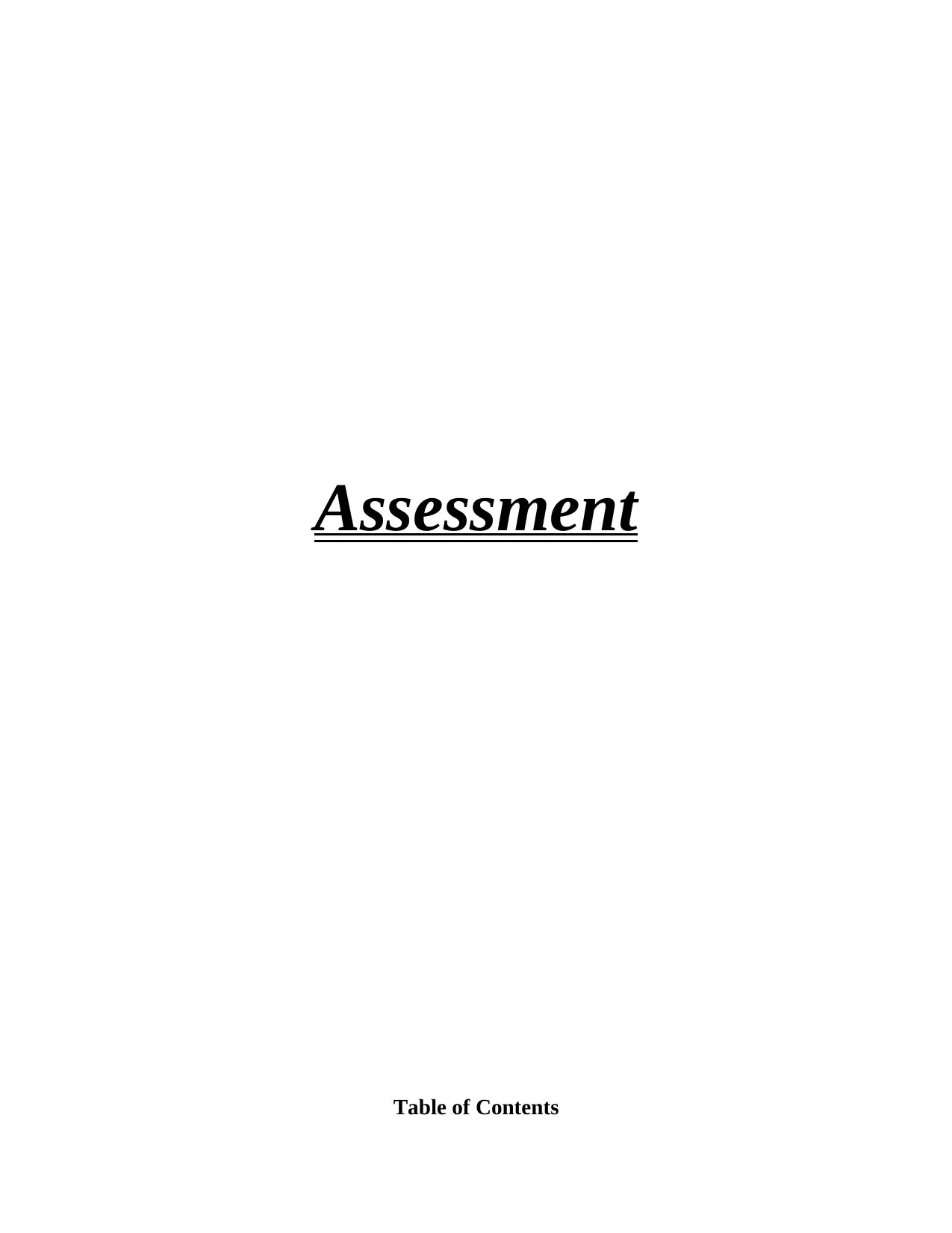
Assessment
Table of Contents
Table of Contents
Paraphrase This Document
Need a fresh take? Get an instant paraphrase of this document with our AI Paraphraser
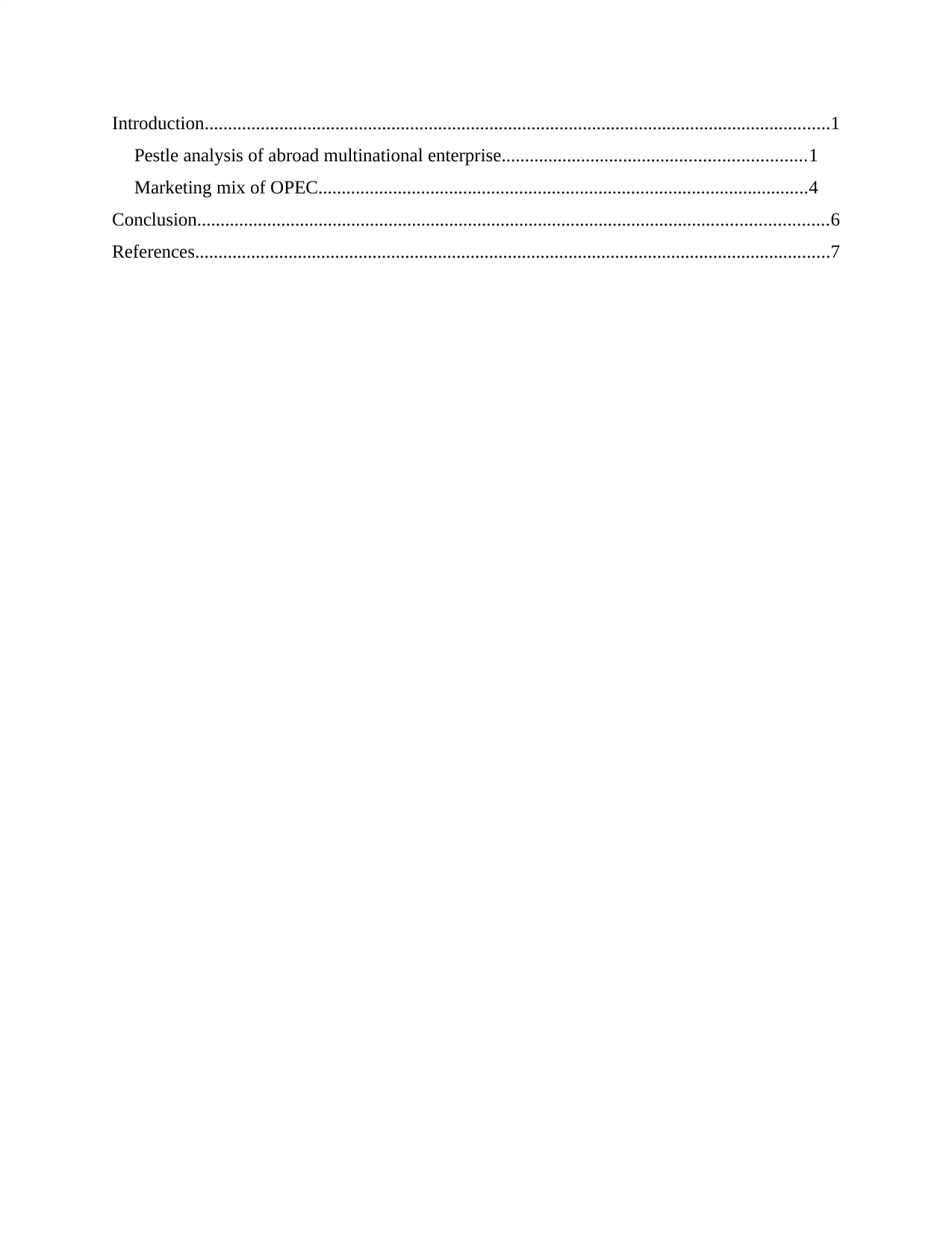
Introduction......................................................................................................................................1
Pestle analysis of abroad multinational enterprise.................................................................1
Marketing mix of OPEC.........................................................................................................4
Conclusion.......................................................................................................................................6
References........................................................................................................................................7
Pestle analysis of abroad multinational enterprise.................................................................1
Marketing mix of OPEC.........................................................................................................4
Conclusion.......................................................................................................................................6
References........................................................................................................................................7
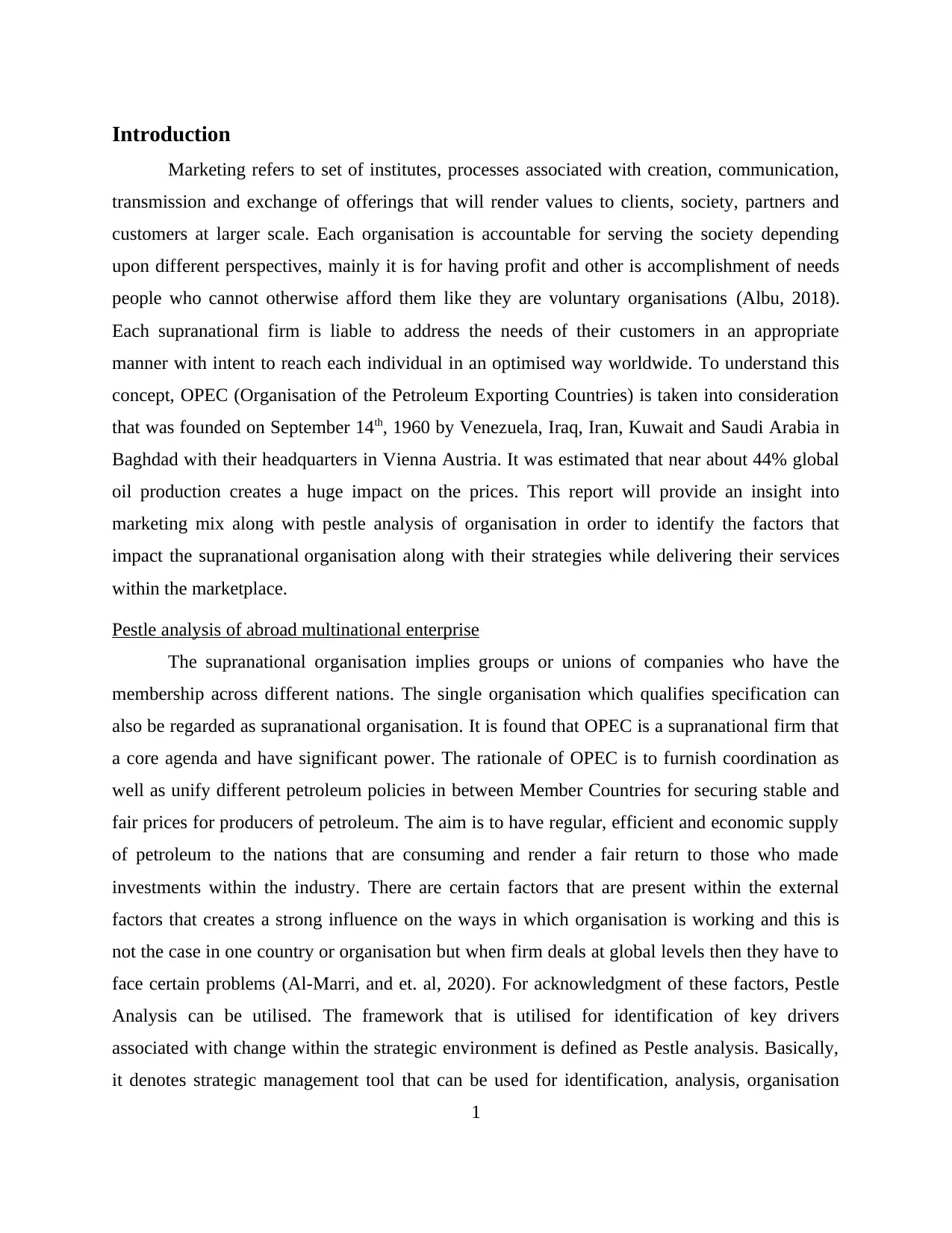
Introduction
Marketing refers to set of institutes, processes associated with creation, communication,
transmission and exchange of offerings that will render values to clients, society, partners and
customers at larger scale. Each organisation is accountable for serving the society depending
upon different perspectives, mainly it is for having profit and other is accomplishment of needs
people who cannot otherwise afford them like they are voluntary organisations (Albu, 2018).
Each supranational firm is liable to address the needs of their customers in an appropriate
manner with intent to reach each individual in an optimised way worldwide. To understand this
concept, OPEC (Organisation of the Petroleum Exporting Countries) is taken into consideration
that was founded on September 14th, 1960 by Venezuela, Iraq, Iran, Kuwait and Saudi Arabia in
Baghdad with their headquarters in Vienna Austria. It was estimated that near about 44% global
oil production creates a huge impact on the prices. This report will provide an insight into
marketing mix along with pestle analysis of organisation in order to identify the factors that
impact the supranational organisation along with their strategies while delivering their services
within the marketplace.
Pestle analysis of abroad multinational enterprise
The supranational organisation implies groups or unions of companies who have the
membership across different nations. The single organisation which qualifies specification can
also be regarded as supranational organisation. It is found that OPEC is a supranational firm that
a core agenda and have significant power. The rationale of OPEC is to furnish coordination as
well as unify different petroleum policies in between Member Countries for securing stable and
fair prices for producers of petroleum. The aim is to have regular, efficient and economic supply
of petroleum to the nations that are consuming and render a fair return to those who made
investments within the industry. There are certain factors that are present within the external
factors that creates a strong influence on the ways in which organisation is working and this is
not the case in one country or organisation but when firm deals at global levels then they have to
face certain problems (Al-Marri, and et. al, 2020). For acknowledgment of these factors, Pestle
Analysis can be utilised. The framework that is utilised for identification of key drivers
associated with change within the strategic environment is defined as Pestle analysis. Basically,
it denotes strategic management tool that can be used for identification, analysis, organisation
1
Marketing refers to set of institutes, processes associated with creation, communication,
transmission and exchange of offerings that will render values to clients, society, partners and
customers at larger scale. Each organisation is accountable for serving the society depending
upon different perspectives, mainly it is for having profit and other is accomplishment of needs
people who cannot otherwise afford them like they are voluntary organisations (Albu, 2018).
Each supranational firm is liable to address the needs of their customers in an appropriate
manner with intent to reach each individual in an optimised way worldwide. To understand this
concept, OPEC (Organisation of the Petroleum Exporting Countries) is taken into consideration
that was founded on September 14th, 1960 by Venezuela, Iraq, Iran, Kuwait and Saudi Arabia in
Baghdad with their headquarters in Vienna Austria. It was estimated that near about 44% global
oil production creates a huge impact on the prices. This report will provide an insight into
marketing mix along with pestle analysis of organisation in order to identify the factors that
impact the supranational organisation along with their strategies while delivering their services
within the marketplace.
Pestle analysis of abroad multinational enterprise
The supranational organisation implies groups or unions of companies who have the
membership across different nations. The single organisation which qualifies specification can
also be regarded as supranational organisation. It is found that OPEC is a supranational firm that
a core agenda and have significant power. The rationale of OPEC is to furnish coordination as
well as unify different petroleum policies in between Member Countries for securing stable and
fair prices for producers of petroleum. The aim is to have regular, efficient and economic supply
of petroleum to the nations that are consuming and render a fair return to those who made
investments within the industry. There are certain factors that are present within the external
factors that creates a strong influence on the ways in which organisation is working and this is
not the case in one country or organisation but when firm deals at global levels then they have to
face certain problems (Al-Marri, and et. al, 2020). For acknowledgment of these factors, Pestle
Analysis can be utilised. The framework that is utilised for identification of key drivers
associated with change within the strategic environment is defined as Pestle analysis. Basically,
it denotes strategic management tool that can be used for identification, analysis, organisation
1
⊘ This is a preview!⊘
Do you want full access?
Subscribe today to unlock all pages.

Trusted by 1+ million students worldwide
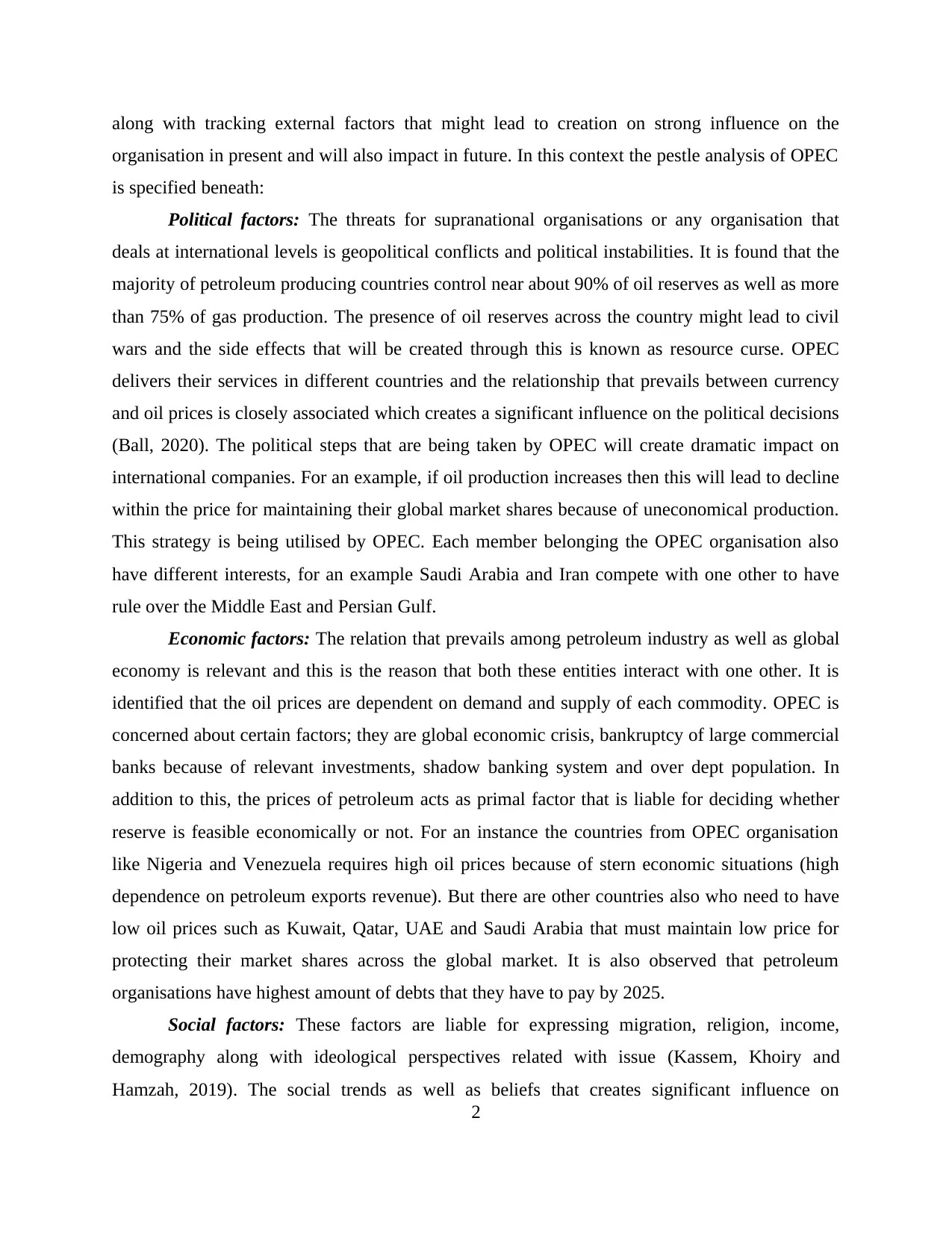
along with tracking external factors that might lead to creation on strong influence on the
organisation in present and will also impact in future. In this context the pestle analysis of OPEC
is specified beneath:
Political factors: The threats for supranational organisations or any organisation that
deals at international levels is geopolitical conflicts and political instabilities. It is found that the
majority of petroleum producing countries control near about 90% of oil reserves as well as more
than 75% of gas production. The presence of oil reserves across the country might lead to civil
wars and the side effects that will be created through this is known as resource curse. OPEC
delivers their services in different countries and the relationship that prevails between currency
and oil prices is closely associated which creates a significant influence on the political decisions
(Ball, 2020). The political steps that are being taken by OPEC will create dramatic impact on
international companies. For an example, if oil production increases then this will lead to decline
within the price for maintaining their global market shares because of uneconomical production.
This strategy is being utilised by OPEC. Each member belonging the OPEC organisation also
have different interests, for an example Saudi Arabia and Iran compete with one other to have
rule over the Middle East and Persian Gulf.
Economic factors: The relation that prevails among petroleum industry as well as global
economy is relevant and this is the reason that both these entities interact with one other. It is
identified that the oil prices are dependent on demand and supply of each commodity. OPEC is
concerned about certain factors; they are global economic crisis, bankruptcy of large commercial
banks because of relevant investments, shadow banking system and over dept population. In
addition to this, the prices of petroleum acts as primal factor that is liable for deciding whether
reserve is feasible economically or not. For an instance the countries from OPEC organisation
like Nigeria and Venezuela requires high oil prices because of stern economic situations (high
dependence on petroleum exports revenue). But there are other countries also who need to have
low oil prices such as Kuwait, Qatar, UAE and Saudi Arabia that must maintain low price for
protecting their market shares across the global market. It is also observed that petroleum
organisations have highest amount of debts that they have to pay by 2025.
Social factors: These factors are liable for expressing migration, religion, income,
demography along with ideological perspectives related with issue (Kassem, Khoiry and
Hamzah, 2019). The social trends as well as beliefs that creates significant influence on
2
organisation in present and will also impact in future. In this context the pestle analysis of OPEC
is specified beneath:
Political factors: The threats for supranational organisations or any organisation that
deals at international levels is geopolitical conflicts and political instabilities. It is found that the
majority of petroleum producing countries control near about 90% of oil reserves as well as more
than 75% of gas production. The presence of oil reserves across the country might lead to civil
wars and the side effects that will be created through this is known as resource curse. OPEC
delivers their services in different countries and the relationship that prevails between currency
and oil prices is closely associated which creates a significant influence on the political decisions
(Ball, 2020). The political steps that are being taken by OPEC will create dramatic impact on
international companies. For an example, if oil production increases then this will lead to decline
within the price for maintaining their global market shares because of uneconomical production.
This strategy is being utilised by OPEC. Each member belonging the OPEC organisation also
have different interests, for an example Saudi Arabia and Iran compete with one other to have
rule over the Middle East and Persian Gulf.
Economic factors: The relation that prevails among petroleum industry as well as global
economy is relevant and this is the reason that both these entities interact with one other. It is
identified that the oil prices are dependent on demand and supply of each commodity. OPEC is
concerned about certain factors; they are global economic crisis, bankruptcy of large commercial
banks because of relevant investments, shadow banking system and over dept population. In
addition to this, the prices of petroleum acts as primal factor that is liable for deciding whether
reserve is feasible economically or not. For an instance the countries from OPEC organisation
like Nigeria and Venezuela requires high oil prices because of stern economic situations (high
dependence on petroleum exports revenue). But there are other countries also who need to have
low oil prices such as Kuwait, Qatar, UAE and Saudi Arabia that must maintain low price for
protecting their market shares across the global market. It is also observed that petroleum
organisations have highest amount of debts that they have to pay by 2025.
Social factors: These factors are liable for expressing migration, religion, income,
demography along with ideological perspectives related with issue (Kassem, Khoiry and
Hamzah, 2019). The social trends as well as beliefs that creates significant influence on
2
Paraphrase This Document
Need a fresh take? Get an instant paraphrase of this document with our AI Paraphraser
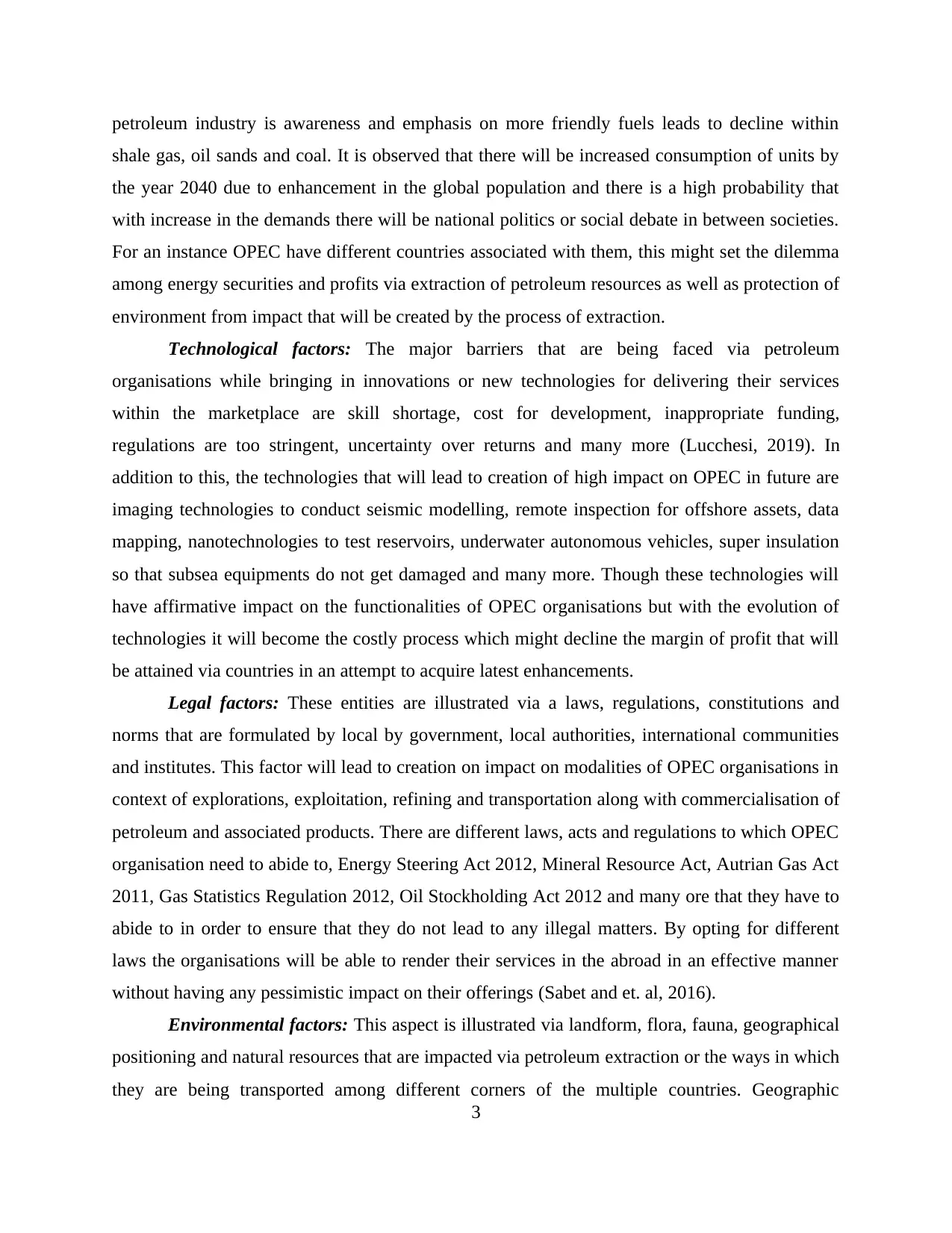
petroleum industry is awareness and emphasis on more friendly fuels leads to decline within
shale gas, oil sands and coal. It is observed that there will be increased consumption of units by
the year 2040 due to enhancement in the global population and there is a high probability that
with increase in the demands there will be national politics or social debate in between societies.
For an instance OPEC have different countries associated with them, this might set the dilemma
among energy securities and profits via extraction of petroleum resources as well as protection of
environment from impact that will be created by the process of extraction.
Technological factors: The major barriers that are being faced via petroleum
organisations while bringing in innovations or new technologies for delivering their services
within the marketplace are skill shortage, cost for development, inappropriate funding,
regulations are too stringent, uncertainty over returns and many more (Lucchesi, 2019). In
addition to this, the technologies that will lead to creation of high impact on OPEC in future are
imaging technologies to conduct seismic modelling, remote inspection for offshore assets, data
mapping, nanotechnologies to test reservoirs, underwater autonomous vehicles, super insulation
so that subsea equipments do not get damaged and many more. Though these technologies will
have affirmative impact on the functionalities of OPEC organisations but with the evolution of
technologies it will become the costly process which might decline the margin of profit that will
be attained via countries in an attempt to acquire latest enhancements.
Legal factors: These entities are illustrated via a laws, regulations, constitutions and
norms that are formulated by local by government, local authorities, international communities
and institutes. This factor will lead to creation on impact on modalities of OPEC organisations in
context of explorations, exploitation, refining and transportation along with commercialisation of
petroleum and associated products. There are different laws, acts and regulations to which OPEC
organisation need to abide to, Energy Steering Act 2012, Mineral Resource Act, Autrian Gas Act
2011, Gas Statistics Regulation 2012, Oil Stockholding Act 2012 and many ore that they have to
abide to in order to ensure that they do not lead to any illegal matters. By opting for different
laws the organisations will be able to render their services in the abroad in an effective manner
without having any pessimistic impact on their offerings (Sabet and et. al, 2016).
Environmental factors: This aspect is illustrated via landform, flora, fauna, geographical
positioning and natural resources that are impacted via petroleum extraction or the ways in which
they are being transported among different corners of the multiple countries. Geographic
3
shale gas, oil sands and coal. It is observed that there will be increased consumption of units by
the year 2040 due to enhancement in the global population and there is a high probability that
with increase in the demands there will be national politics or social debate in between societies.
For an instance OPEC have different countries associated with them, this might set the dilemma
among energy securities and profits via extraction of petroleum resources as well as protection of
environment from impact that will be created by the process of extraction.
Technological factors: The major barriers that are being faced via petroleum
organisations while bringing in innovations or new technologies for delivering their services
within the marketplace are skill shortage, cost for development, inappropriate funding,
regulations are too stringent, uncertainty over returns and many more (Lucchesi, 2019). In
addition to this, the technologies that will lead to creation of high impact on OPEC in future are
imaging technologies to conduct seismic modelling, remote inspection for offshore assets, data
mapping, nanotechnologies to test reservoirs, underwater autonomous vehicles, super insulation
so that subsea equipments do not get damaged and many more. Though these technologies will
have affirmative impact on the functionalities of OPEC organisations but with the evolution of
technologies it will become the costly process which might decline the margin of profit that will
be attained via countries in an attempt to acquire latest enhancements.
Legal factors: These entities are illustrated via a laws, regulations, constitutions and
norms that are formulated by local by government, local authorities, international communities
and institutes. This factor will lead to creation on impact on modalities of OPEC organisations in
context of explorations, exploitation, refining and transportation along with commercialisation of
petroleum and associated products. There are different laws, acts and regulations to which OPEC
organisation need to abide to, Energy Steering Act 2012, Mineral Resource Act, Autrian Gas Act
2011, Gas Statistics Regulation 2012, Oil Stockholding Act 2012 and many ore that they have to
abide to in order to ensure that they do not lead to any illegal matters. By opting for different
laws the organisations will be able to render their services in the abroad in an effective manner
without having any pessimistic impact on their offerings (Sabet and et. al, 2016).
Environmental factors: This aspect is illustrated via landform, flora, fauna, geographical
positioning and natural resources that are impacted via petroleum extraction or the ways in which
they are being transported among different corners of the multiple countries. Geographic
3
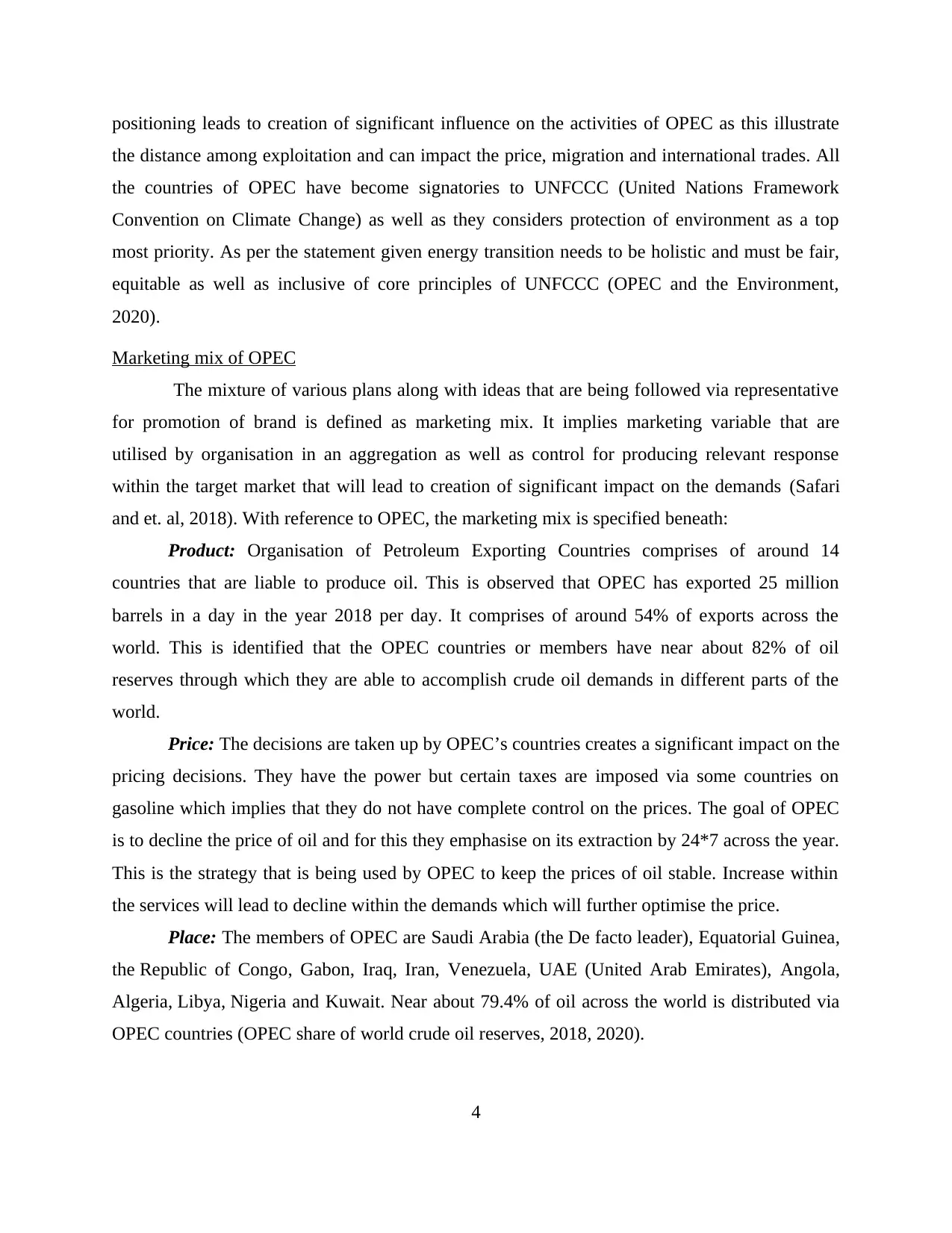
positioning leads to creation of significant influence on the activities of OPEC as this illustrate
the distance among exploitation and can impact the price, migration and international trades. All
the countries of OPEC have become signatories to UNFCCC (United Nations Framework
Convention on Climate Change) as well as they considers protection of environment as a top
most priority. As per the statement given energy transition needs to be holistic and must be fair,
equitable as well as inclusive of core principles of UNFCCC (OPEC and the Environment,
2020).
Marketing mix of OPEC
The mixture of various plans along with ideas that are being followed via representative
for promotion of brand is defined as marketing mix. It implies marketing variable that are
utilised by organisation in an aggregation as well as control for producing relevant response
within the target market that will lead to creation of significant impact on the demands (Safari
and et. al, 2018). With reference to OPEC, the marketing mix is specified beneath:
Product: Organisation of Petroleum Exporting Countries comprises of around 14
countries that are liable to produce oil. This is observed that OPEC has exported 25 million
barrels in a day in the year 2018 per day. It comprises of around 54% of exports across the
world. This is identified that the OPEC countries or members have near about 82% of oil
reserves through which they are able to accomplish crude oil demands in different parts of the
world.
Price: The decisions are taken up by OPEC’s countries creates a significant impact on the
pricing decisions. They have the power but certain taxes are imposed via some countries on
gasoline which implies that they do not have complete control on the prices. The goal of OPEC
is to decline the price of oil and for this they emphasise on its extraction by 24*7 across the year.
This is the strategy that is being used by OPEC to keep the prices of oil stable. Increase within
the services will lead to decline within the demands which will further optimise the price.
Place: The members of OPEC are Saudi Arabia (the De facto leader), Equatorial Guinea,
the Republic of Congo, Gabon, Iraq, Iran, Venezuela, UAE (United Arab Emirates), Angola,
Algeria, Libya, Nigeria and Kuwait. Near about 79.4% of oil across the world is distributed via
OPEC countries (OPEC share of world crude oil reserves, 2018, 2020).
4
the distance among exploitation and can impact the price, migration and international trades. All
the countries of OPEC have become signatories to UNFCCC (United Nations Framework
Convention on Climate Change) as well as they considers protection of environment as a top
most priority. As per the statement given energy transition needs to be holistic and must be fair,
equitable as well as inclusive of core principles of UNFCCC (OPEC and the Environment,
2020).
Marketing mix of OPEC
The mixture of various plans along with ideas that are being followed via representative
for promotion of brand is defined as marketing mix. It implies marketing variable that are
utilised by organisation in an aggregation as well as control for producing relevant response
within the target market that will lead to creation of significant impact on the demands (Safari
and et. al, 2018). With reference to OPEC, the marketing mix is specified beneath:
Product: Organisation of Petroleum Exporting Countries comprises of around 14
countries that are liable to produce oil. This is observed that OPEC has exported 25 million
barrels in a day in the year 2018 per day. It comprises of around 54% of exports across the
world. This is identified that the OPEC countries or members have near about 82% of oil
reserves through which they are able to accomplish crude oil demands in different parts of the
world.
Price: The decisions are taken up by OPEC’s countries creates a significant impact on the
pricing decisions. They have the power but certain taxes are imposed via some countries on
gasoline which implies that they do not have complete control on the prices. The goal of OPEC
is to decline the price of oil and for this they emphasise on its extraction by 24*7 across the year.
This is the strategy that is being used by OPEC to keep the prices of oil stable. Increase within
the services will lead to decline within the demands which will further optimise the price.
Place: The members of OPEC are Saudi Arabia (the De facto leader), Equatorial Guinea,
the Republic of Congo, Gabon, Iraq, Iran, Venezuela, UAE (United Arab Emirates), Angola,
Algeria, Libya, Nigeria and Kuwait. Near about 79.4% of oil across the world is distributed via
OPEC countries (OPEC share of world crude oil reserves, 2018, 2020).
4
⊘ This is a preview!⊘
Do you want full access?
Subscribe today to unlock all pages.

Trusted by 1+ million students worldwide
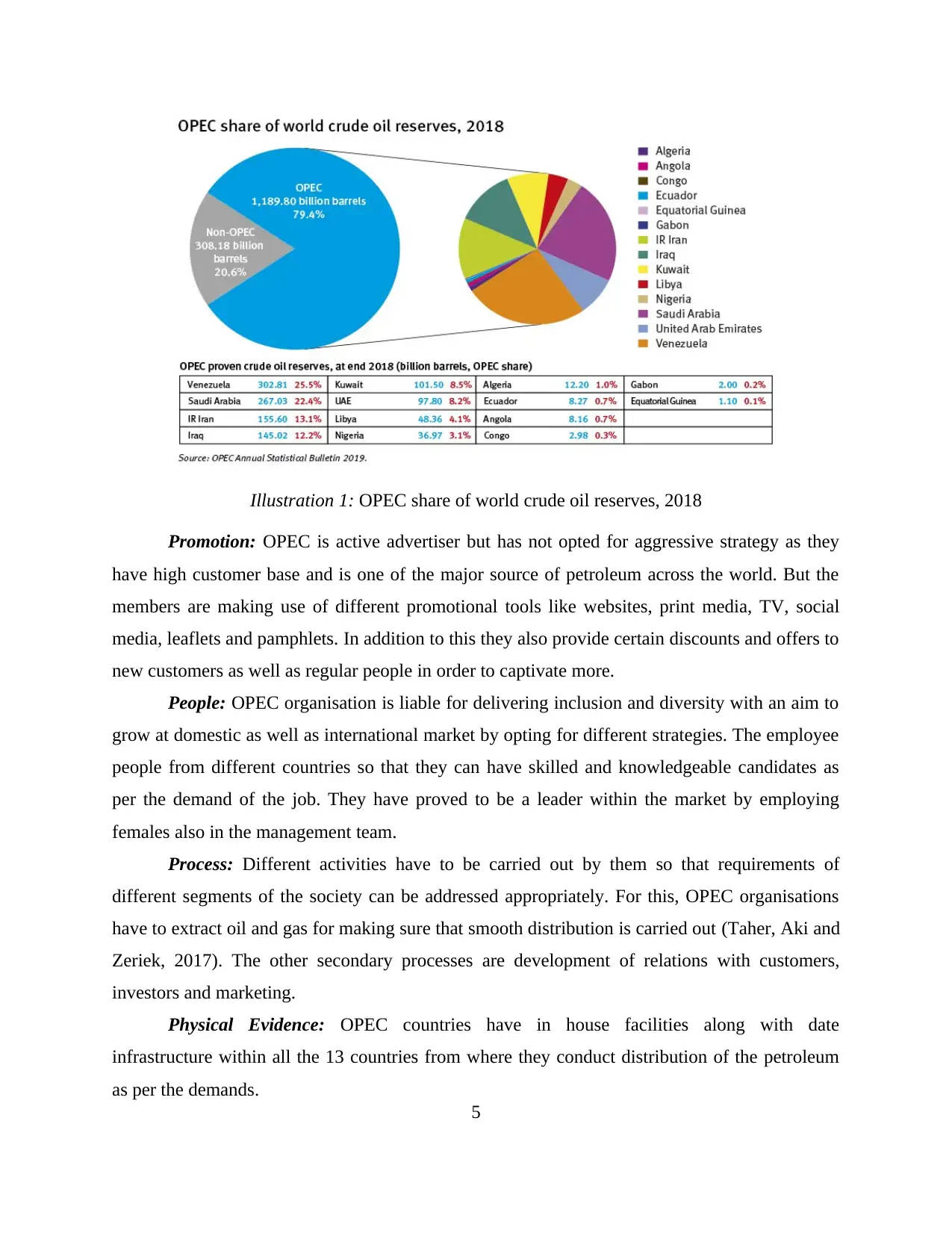
Illustration 1: OPEC share of world crude oil reserves, 2018
Promotion: OPEC is active advertiser but has not opted for aggressive strategy as they
have high customer base and is one of the major source of petroleum across the world. But the
members are making use of different promotional tools like websites, print media, TV, social
media, leaflets and pamphlets. In addition to this they also provide certain discounts and offers to
new customers as well as regular people in order to captivate more.
People: OPEC organisation is liable for delivering inclusion and diversity with an aim to
grow at domestic as well as international market by opting for different strategies. The employee
people from different countries so that they can have skilled and knowledgeable candidates as
per the demand of the job. They have proved to be a leader within the market by employing
females also in the management team.
Process: Different activities have to be carried out by them so that requirements of
different segments of the society can be addressed appropriately. For this, OPEC organisations
have to extract oil and gas for making sure that smooth distribution is carried out (Taher, Aki and
Zeriek, 2017). The other secondary processes are development of relations with customers,
investors and marketing.
Physical Evidence: OPEC countries have in house facilities along with date
infrastructure within all the 13 countries from where they conduct distribution of the petroleum
as per the demands.
5
Promotion: OPEC is active advertiser but has not opted for aggressive strategy as they
have high customer base and is one of the major source of petroleum across the world. But the
members are making use of different promotional tools like websites, print media, TV, social
media, leaflets and pamphlets. In addition to this they also provide certain discounts and offers to
new customers as well as regular people in order to captivate more.
People: OPEC organisation is liable for delivering inclusion and diversity with an aim to
grow at domestic as well as international market by opting for different strategies. The employee
people from different countries so that they can have skilled and knowledgeable candidates as
per the demand of the job. They have proved to be a leader within the market by employing
females also in the management team.
Process: Different activities have to be carried out by them so that requirements of
different segments of the society can be addressed appropriately. For this, OPEC organisations
have to extract oil and gas for making sure that smooth distribution is carried out (Taher, Aki and
Zeriek, 2017). The other secondary processes are development of relations with customers,
investors and marketing.
Physical Evidence: OPEC countries have in house facilities along with date
infrastructure within all the 13 countries from where they conduct distribution of the petroleum
as per the demands.
5
Paraphrase This Document
Need a fresh take? Get an instant paraphrase of this document with our AI Paraphraser
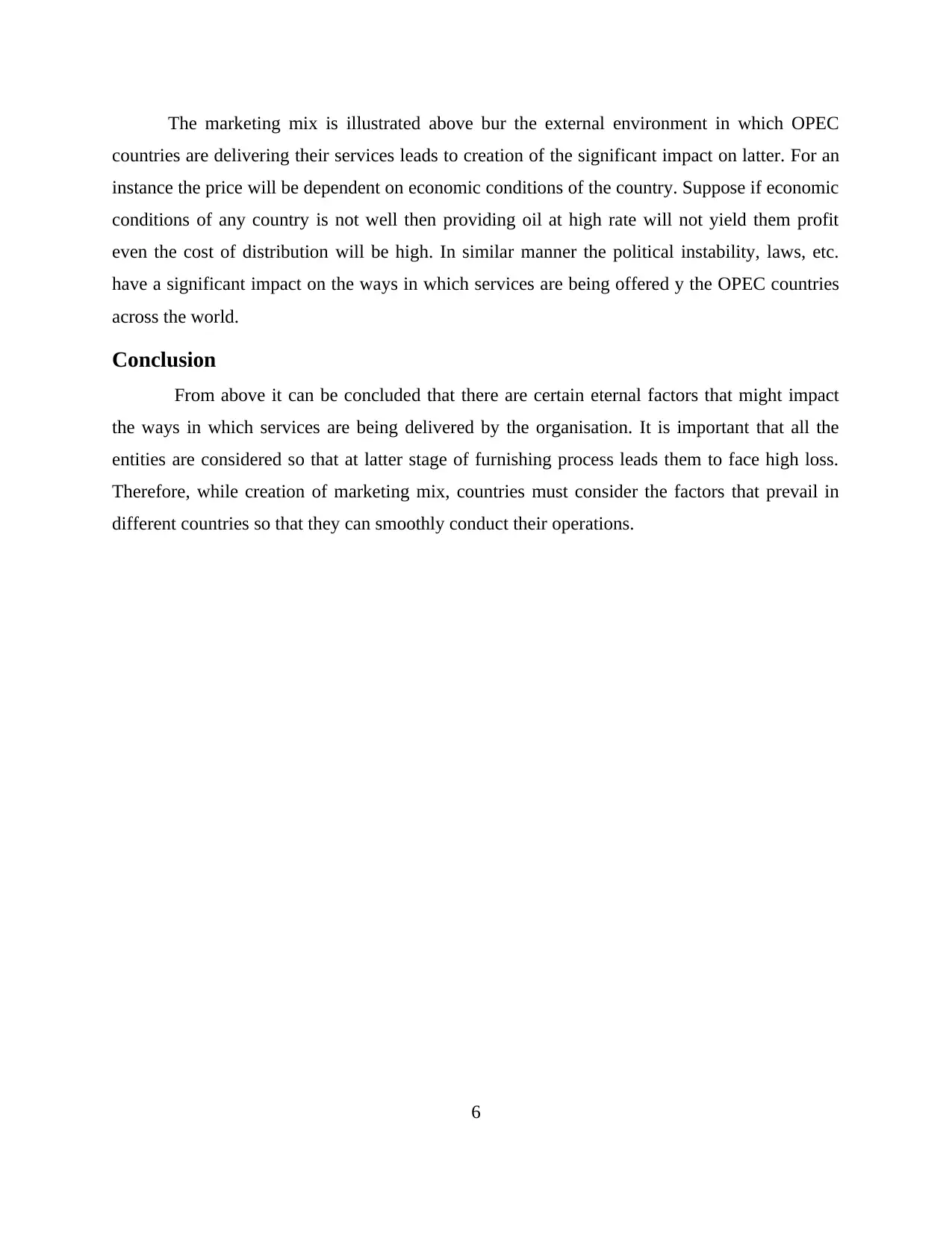
The marketing mix is illustrated above bur the external environment in which OPEC
countries are delivering their services leads to creation of the significant impact on latter. For an
instance the price will be dependent on economic conditions of the country. Suppose if economic
conditions of any country is not well then providing oil at high rate will not yield them profit
even the cost of distribution will be high. In similar manner the political instability, laws, etc.
have a significant impact on the ways in which services are being offered y the OPEC countries
across the world.
Conclusion
From above it can be concluded that there are certain eternal factors that might impact
the ways in which services are being delivered by the organisation. It is important that all the
entities are considered so that at latter stage of furnishing process leads them to face high loss.
Therefore, while creation of marketing mix, countries must consider the factors that prevail in
different countries so that they can smoothly conduct their operations.
6
countries are delivering their services leads to creation of the significant impact on latter. For an
instance the price will be dependent on economic conditions of the country. Suppose if economic
conditions of any country is not well then providing oil at high rate will not yield them profit
even the cost of distribution will be high. In similar manner the political instability, laws, etc.
have a significant impact on the ways in which services are being offered y the OPEC countries
across the world.
Conclusion
From above it can be concluded that there are certain eternal factors that might impact
the ways in which services are being delivered by the organisation. It is important that all the
entities are considered so that at latter stage of furnishing process leads them to face high loss.
Therefore, while creation of marketing mix, countries must consider the factors that prevail in
different countries so that they can smoothly conduct their operations.
6
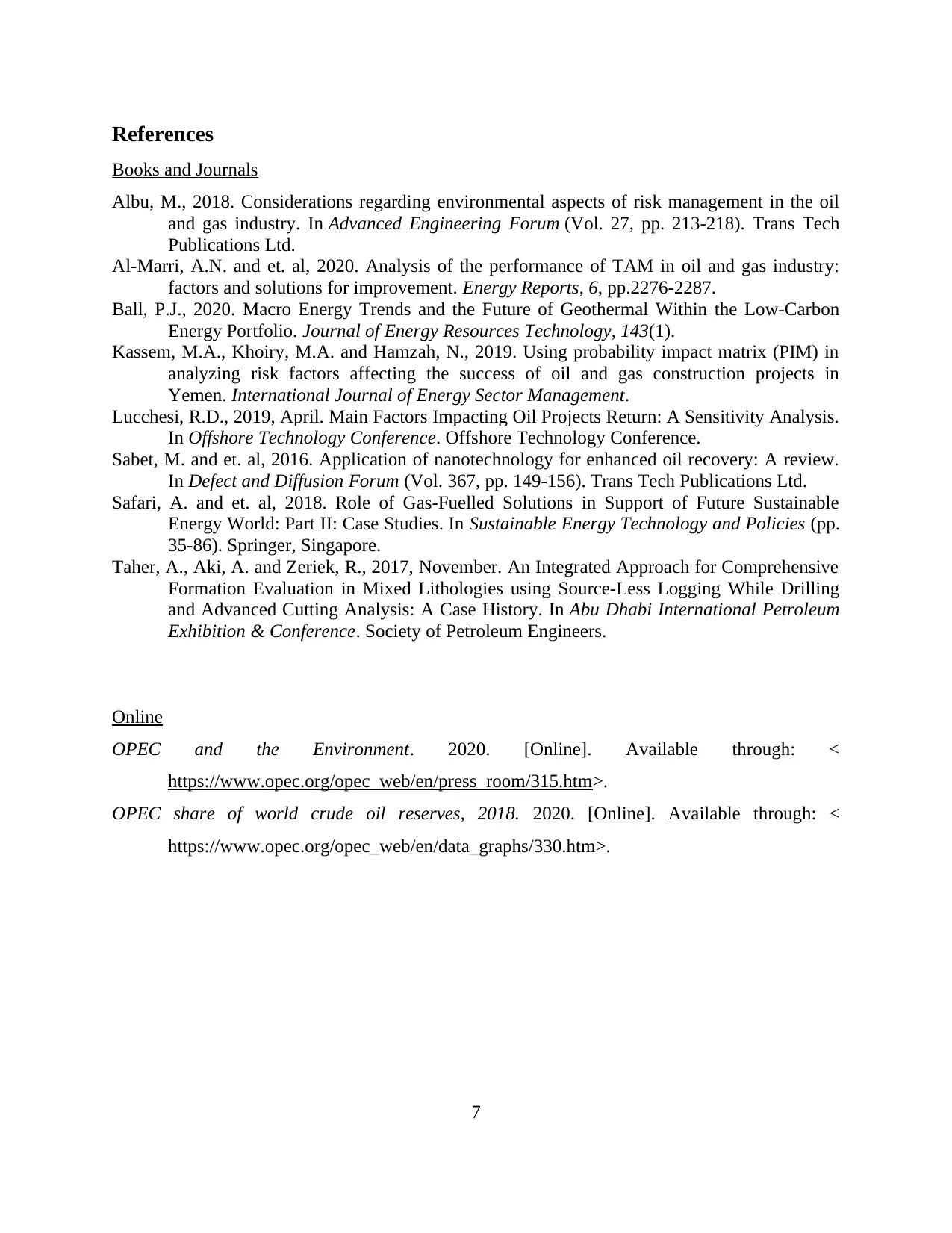
References
Books and Journals
Albu, M., 2018. Considerations regarding environmental aspects of risk management in the oil
and gas industry. In Advanced Engineering Forum (Vol. 27, pp. 213-218). Trans Tech
Publications Ltd.
Al-Marri, A.N. and et. al, 2020. Analysis of the performance of TAM in oil and gas industry:
factors and solutions for improvement. Energy Reports, 6, pp.2276-2287.
Ball, P.J., 2020. Macro Energy Trends and the Future of Geothermal Within the Low-Carbon
Energy Portfolio. Journal of Energy Resources Technology, 143(1).
Kassem, M.A., Khoiry, M.A. and Hamzah, N., 2019. Using probability impact matrix (PIM) in
analyzing risk factors affecting the success of oil and gas construction projects in
Yemen. International Journal of Energy Sector Management.
Lucchesi, R.D., 2019, April. Main Factors Impacting Oil Projects Return: A Sensitivity Analysis.
In Offshore Technology Conference. Offshore Technology Conference.
Sabet, M. and et. al, 2016. Application of nanotechnology for enhanced oil recovery: A review.
In Defect and Diffusion Forum (Vol. 367, pp. 149-156). Trans Tech Publications Ltd.
Safari, A. and et. al, 2018. Role of Gas-Fuelled Solutions in Support of Future Sustainable
Energy World: Part II: Case Studies. In Sustainable Energy Technology and Policies (pp.
35-86). Springer, Singapore.
Taher, A., Aki, A. and Zeriek, R., 2017, November. An Integrated Approach for Comprehensive
Formation Evaluation in Mixed Lithologies using Source-Less Logging While Drilling
and Advanced Cutting Analysis: A Case History. In Abu Dhabi International Petroleum
Exhibition & Conference. Society of Petroleum Engineers.
Online
OPEC and the Environment. 2020. [Online]. Available through: <
https://www.opec.org/opec_web/en/press_room/315.htm>.
OPEC share of world crude oil reserves, 2018. 2020. [Online]. Available through: <
https://www.opec.org/opec_web/en/data_graphs/330.htm>.
7
Books and Journals
Albu, M., 2018. Considerations regarding environmental aspects of risk management in the oil
and gas industry. In Advanced Engineering Forum (Vol. 27, pp. 213-218). Trans Tech
Publications Ltd.
Al-Marri, A.N. and et. al, 2020. Analysis of the performance of TAM in oil and gas industry:
factors and solutions for improvement. Energy Reports, 6, pp.2276-2287.
Ball, P.J., 2020. Macro Energy Trends and the Future of Geothermal Within the Low-Carbon
Energy Portfolio. Journal of Energy Resources Technology, 143(1).
Kassem, M.A., Khoiry, M.A. and Hamzah, N., 2019. Using probability impact matrix (PIM) in
analyzing risk factors affecting the success of oil and gas construction projects in
Yemen. International Journal of Energy Sector Management.
Lucchesi, R.D., 2019, April. Main Factors Impacting Oil Projects Return: A Sensitivity Analysis.
In Offshore Technology Conference. Offshore Technology Conference.
Sabet, M. and et. al, 2016. Application of nanotechnology for enhanced oil recovery: A review.
In Defect and Diffusion Forum (Vol. 367, pp. 149-156). Trans Tech Publications Ltd.
Safari, A. and et. al, 2018. Role of Gas-Fuelled Solutions in Support of Future Sustainable
Energy World: Part II: Case Studies. In Sustainable Energy Technology and Policies (pp.
35-86). Springer, Singapore.
Taher, A., Aki, A. and Zeriek, R., 2017, November. An Integrated Approach for Comprehensive
Formation Evaluation in Mixed Lithologies using Source-Less Logging While Drilling
and Advanced Cutting Analysis: A Case History. In Abu Dhabi International Petroleum
Exhibition & Conference. Society of Petroleum Engineers.
Online
OPEC and the Environment. 2020. [Online]. Available through: <
https://www.opec.org/opec_web/en/press_room/315.htm>.
OPEC share of world crude oil reserves, 2018. 2020. [Online]. Available through: <
https://www.opec.org/opec_web/en/data_graphs/330.htm>.
7
⊘ This is a preview!⊘
Do you want full access?
Subscribe today to unlock all pages.

Trusted by 1+ million students worldwide
1 out of 9
Related Documents
Your All-in-One AI-Powered Toolkit for Academic Success.
+13062052269
info@desklib.com
Available 24*7 on WhatsApp / Email
![[object Object]](/_next/static/media/star-bottom.7253800d.svg)
Unlock your academic potential
Copyright © 2020–2025 A2Z Services. All Rights Reserved. Developed and managed by ZUCOL.




